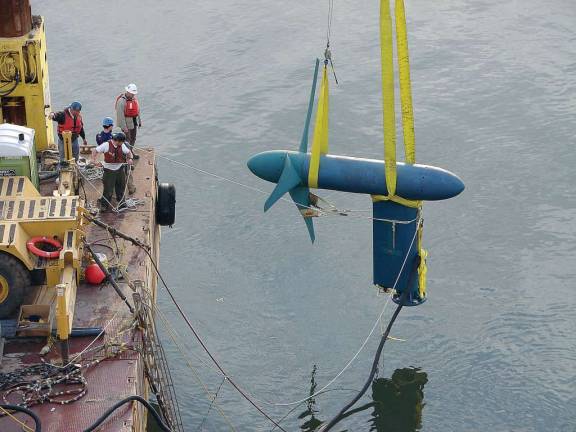Harnessing the Power of the East River

Electricity generated from the ebb and flow of the East River's tides is about to become part of New York City's energy mix. Verdant Power, a Roosevelt Island-based renewable energy startup, received permission last month to develop the first commercial tidal power project in U.S. history.
The company had already been powering a Roosevelt Island Gristedes supermarket and nearby parking garage with its underwater turbines. Now it will be able to put in more turbines and actually sell the electricity it produces.
Under the terms of a "pilot commercial license," Verdant plans to install 30 turbines in the East River that will produce over 1 megawatt of carbon-free electricity, enough to power about 800 homes. The turbines will be set up in stages, the last going in by 2015.
"New York City's power demand is about 25,000 megawatts," said Trey Taylor, co-founder and president of Verdant. "One megawatt doesn't make much of a dent, but over time there could be more power added."
The East River is currently the best site for tidal power in New York thanks to its fast-moving waters, but the Hudson River and the Narrows strait should also eventually be able to support projects, Taylor pointed out.
"I think that [tidal power] technology has some nice advantages, and I think they are well displayed at the Roosevelt Island project," said Paul Jacobson, an expert at the Electric Power Research Institute with no direct connection to Verdant.
He added, "You've got an untapped resource in close proximity to the demand, you can potentially generate electricity in a way that is unobtrusive to the public and all indications are that it will be environmentally benign."
Underwater turbines have not, for example, been observed to strike birds and other animals, unlike their wind-powered brethren.
The 17-mile-long East River, which connects Long Island Sound to New York Harbor, is not really a river at all. Rather, it is a saltwater strait that can flow in either direction depending on the tides.
Verdant first received a preliminary permit for this project back in 2002. Then, in 2006, it began testing six turbines-each about five meters in diameter-that were anchored to the bottom of the river's east channel.
High water pressure initially caused some rotor failures, but Verdant was able to overcome the problem by using stronger construction materials, according to Taylor.
"There's a real science and art to figuring out how to position these turbines," Taylor said.
The six turbines that powered the Gristedes and the parking garage are now out of the water and will be replaced by a new generation of tri-frame turbines.
Verdant's pilot commercial license, issued Jan. 23 by the Federal Energy Regulatory Commission (FERC) is only good for 10 years. It further stipulates that the Roosevelt Island project must be small, short-term, located in an environmentally non-sensitive area and easily removable.
Nonetheless, FERC Chairman Jon Wellinghoff touted it as "a major step in the effort to help our country meet our renewable energy goals."
In a statement, he said, "FERC's pilot process is doing what it should: allowing for exploration of new renewable technologies while protecting the environment."
If all goes well, Verdant will eventually apply for a roughly 30-year commercial license, said Taylor, who called tidal power "predictable, reliable and clean."
Verdant is not the only company looking to harvest energy from the East River's tides. In fact, at least three other projects there have also received preliminary permits from FERC.
Dozens of preliminary permits have likewise been issued for tidal and wave power projects in such states as Alaska, Washington and Maine. For now, though, Verdant is the farthest along.
"The Verdant license is a very important first and an important step forward for the industry," Jacobson said.